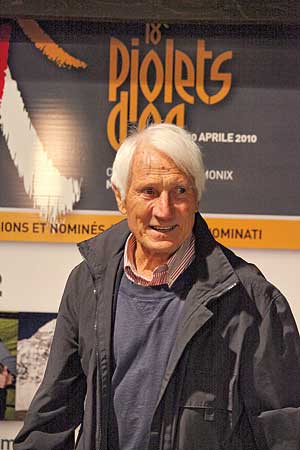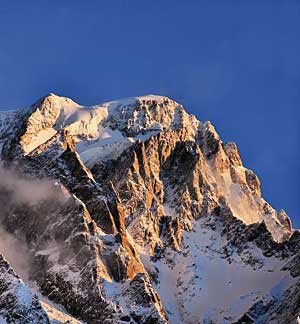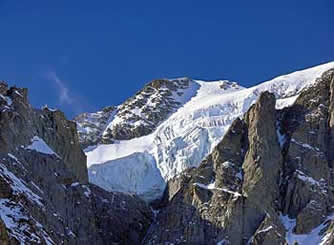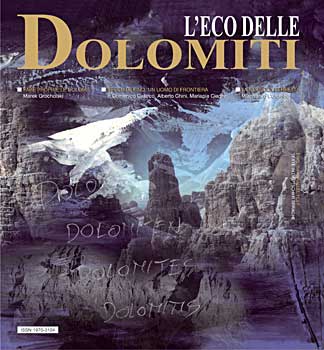WALTER BONATTI,
A CLASSIC CONTEMPORARY LEGEND
Sonia Sbolzani
 When the gods talked with men and the world was populated by heroes, mountaineering was a kind of civil religion, an allegory of the sufferings and sacrifices to be endured for a better future. When the gods talked with men and the world was populated by heroes, mountaineering was a kind of civil religion, an allegory of the sufferings and sacrifices to be endured for a better future.
Nowadays mountaineering has lost much of the mythical aura which made it a complete sport, full of technique and passion, emotion and searching, resistance and defiance, which had little or no interest in stop watches, awards, advertising, and which was not adverse to extreme transgressions.
Walter Bonatti is still a symbol of that “rocky” heroism; a splendid octogenarian with gray hair who maintains the enthusiasm and young spirit of the most capable youths.
Born in 1930 in Bergamo, he was the protagonist of a fifteen year period of exceptional achievements (sometimes dramatic and with consequential controversy) until his sudden decision in 1965 to retire from the world of climbing. He then devoted himself successfully to travel reporting for the weekly magazine “Epoca”, confirming himself as a capable explorer – with a backpack on his shoulders and a camera in his hand - to embody an authentic spirit of adventure, even reinventing and revitalizing the profession of travel reporter (before getting to know him, the woman who was to become his life-time companion, the famous actress Rossana Podesta, revealed in an interview that if she had not become an actress she would have wanted to assist Walter Bonatti by carrying his cameras).
 Reserved and introverted, resistant to the alluring call of consumerism and the media, Bonatti always tried to carry out his extraordinary climbing activities out of the spotlight, even if sometimes it was he who broke the silence. The most famous episode is linked to the Italian conquest of K2 in 1954; he succeeded in obtaining fundamental changes to the official story, authoritatively documenting his decisive contribution to the success of Achille Compagnoni and Lino Lacedelli in the expedition led by Ardito Desio in Karakorum (the then twenty-four year old Bonatti, who carried the oxygen bottles for his companions, endured terrible camping conditions at a height of over 8,000 meters, and escaped death by a miracle). Reserved and introverted, resistant to the alluring call of consumerism and the media, Bonatti always tried to carry out his extraordinary climbing activities out of the spotlight, even if sometimes it was he who broke the silence. The most famous episode is linked to the Italian conquest of K2 in 1954; he succeeded in obtaining fundamental changes to the official story, authoritatively documenting his decisive contribution to the success of Achille Compagnoni and Lino Lacedelli in the expedition led by Ardito Desio in Karakorum (the then twenty-four year old Bonatti, who carried the oxygen bottles for his companions, endured terrible camping conditions at a height of over 8,000 meters, and escaped death by a miracle).
His name is also linked to other legendary ascents of an audacious and tenacious nature, although they sometimes ended in tragedy: consider, for example, the fatal attempt to climb the central pillar of Freney in 1961, when the two Italian and French teams, which had already arrived at the summit of Mont Blanc, were blocked for days by a storm and forced to retreat (led by Bonatti, who was only able to save one of the six men who accompanied him). Then there was the solo climb on the Southwest Pillar of the Dru (the most beautiful summit of Mont Blanc on the French side) which he achieved in six extremely difficult days in 1955  (on this occasion the magazine Paris-Match called him "the greatest climber in the world"). Already in 1951, when he was an unknown worker at the Falck steel works, Bonatti had conquered the East face of the Grand Capucin, in the bigger part of Mont Blanc, along with Luciano Ghigo (who worked in Fiat’s steel business). It was he who also opened a new route on the north side of the Matterhorn (always solo, and moreover during the winter), his last amazing achievement before retiring. (on this occasion the magazine Paris-Match called him "the greatest climber in the world"). Already in 1951, when he was an unknown worker at the Falck steel works, Bonatti had conquered the East face of the Grand Capucin, in the bigger part of Mont Blanc, along with Luciano Ghigo (who worked in Fiat’s steel business). It was he who also opened a new route on the north side of the Matterhorn (always solo, and moreover during the winter), his last amazing achievement before retiring.
Even if he is no longer part of the scene, in the present day Walter Bonatti continues to be involved in mountaineering, having become an excellent testimonial to that heroic world which is now far away in time. At eighty years of age, lived as intensely as a difficult ascent, we pay homage to him in a small way with this article, in the certainty that when you are a legend you never grow old!
|
 NUMBER 10
NUMBER 10

 NUMBER 10
NUMBER 10
